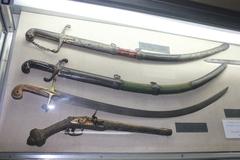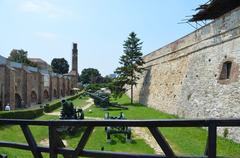
Belgrade Military Museum: Visiting Hours, Tickets, and Guide to Historical Sites in Belgrade
Date: 14/06/2025
Introduction
The Belgrade Military Museum, prominently located within the historic Kalemegdan Fortress at the confluence of the Sava and Danube rivers, stands as a premier destination for anyone interested in Serbia’s multifaceted military past. Established in 1878 following Serbia’s independence, the museum has grown into an extensive institution chronicling over fourteen centuries of regional military history—from the earliest prehistoric relics to artifacts from the modern conflicts of the 20th century. Its unique position within the fortress enriches the visitor experience, offering both a tangible sense of history and panoramic views of Belgrade.
This guide provides a detailed overview of the museum’s historical importance, collections, and visitor amenities. It covers practical information such as visiting hours, ticket prices, accessibility, guided tours, and nearby attractions, ensuring a well-planned visit for history enthusiasts, students, and travelers alike. For further trip planning, consult the official museum website and reputable travel resources (Military Museum Official Site, Serbia Travel Guide, Belgrade Fortress History).
Table of Contents
- Historical Background
- Visiting the Belgrade Military Museum
- Collection Highlights and Notable Artifacts
- Architectural and Cultural Significance
- Role in Education and Remembrance
- Preservation and Modernization Efforts
- Frequently Asked Questions (FAQ)
- Conclusion
- Sources
Historical Background
Origins and Establishment
The Belgrade Military Museum was established in 1878, soon after Serbia gained independence from Ottoman rule. Conceived as a repository for Serbian military heritage, its early collections consisted primarily of weapons, uniforms, and memorabilia donated by military personnel and citizens. Over time, the museum’s holdings expanded to reflect the turbulent history and evolving military traditions of Serbia and the Balkans (Military Museum Official Site).
In 1956, the museum moved to its current home within Kalemegdan Fortress, amplifying its historical ambiance and offering visitors a unique synergy between the exhibits and the centuries-old fortress (Serbia.com).
Evolution Through Historical Periods
- Prehistoric and Ancient Times: The museum’s earliest artifacts include Neolithic and Bronze Age tools and weapons, as well as Roman-era swords, helmets, and military equipment, providing invaluable insight into the region’s earliest military practices (Trip.com).
- Medieval Era: Displays feature Serbian knightly swords, Ottoman arms, heraldic banners, and armor from the Middle Ages, reflecting the area’s complex history of shifting borders and frequent conflicts.
- Ottoman and Austro-Hungarian Periods: Artifacts from centuries of Ottoman occupation and Austro-Hungarian influence, including firearms, cannons, and military documents, illustrate the region’s contested legacy (Belgrade Fortress History).
- Serbian Uprisings and Independence: Exhibits highlight the First and Second Serbian Uprisings (1804–1815) with original weapons, uniforms, and personal effects of leaders like Karađorđe Petrović and Miloš Obrenović (Serbia Travel Guide).
- World Wars and Yugoslav Era: The museum documents Serbia’s significant contributions and sacrifices in World War I and II, the anti-fascist struggle, and the development of the Yugoslav military, including Cold War-era equipment and Yugoslav tanks (Visit Belgrade).
- Recent History: Notable exhibits include wreckage from the 1999 NATO bombing and the Yugoslav Wars, such as parts of a downed US F-117 Nighthawk (BBC News).
Visiting the Belgrade Military Museum
Visiting Hours
- Open: Tuesday to Sunday, 10:00 AM – 6:00 PM
- Closed: Mondays and select public holidays
Always check the official website for the latest updates.
Tickets and Admission
- General Admission: Approximately €5 (400 Serbian dinars)
- Discounts: Available for students, seniors, and groups
- Free Entry: Children under 7
- Purchase: Tickets are available at the museum entrance; some special tours may require advance booking.
Location and Getting There
- Address: Within Kalemegdan Fortress, at the Sava and Danube confluence, central Belgrade (BelgradeSpots)
- Access:
- Public transport (bus, tram, trolley lines to Kalemegdan)
- Walking (from city center via Knez Mihailova Street)
- Taxi or ride-sharing services
Accessibility
- Indoor Areas: Most exhibition halls are wheelchair accessible.
- Outdoor Areas: Terrain may be uneven due to the historic fortress setting; assistance is available upon request.
- Signage: Exhibits are labeled in both Serbian and English.
Guided Tours and Special Events
- Guided Tours: Offered in Serbian and English, ideal for in-depth exploration (advance booking recommended for groups).
- Special Exhibitions: Thematic displays and commemorative events, often aligned with significant anniversaries, are held throughout the year (MakeMyTrip).
Nearby Attractions
- Within Kalemegdan Fortress:
- The Victor Monument
- Roman Well
- Kalemegdan Park
- Nearby: Belgrade Zoo, Knez Mihailova Street, and riverside viewpoints
Collection Highlights and Notable Artifacts
- Prehistoric Tools: Neolithic stone axes, Bronze Age weapons
- Roman and Byzantine Relics: Swords, helmets, and military equipment
- Medieval Weaponry: Serbian knight swords, Ottoman yataghans, armor, and siege weapons
- 19th–20th Century Firearms: Muskets, rifles, and artillery from the Balkan Wars and World Wars
- World War I & II Memorabilia: Uniforms, medals, diaries, and photographs
- Cold War and Yugoslav Era: M84 and T-34 tanks, MiG-21 jets
- Recent History: Fragments of NATO missiles and a US F-117 stealth aircraft (Serbia.com)
- Outdoor Displays: Cannons, heavy artillery, armored vehicles, and naval equipment along fortress ramparts
Architectural and Cultural Significance
The museum occupies a 1924 building originally intended for the Military-Geographic Institute, seamlessly integrated into the ancient fortress walls. The main hall’s chronological layout, natural lighting, and spacious galleries create an inviting atmosphere. The outdoor collection, set along the fortress ramparts, is among Southeast Europe’s most extensive. A dedicated library supports research with over 15,000 books and 6,000 periodicals (belgradecard.rs).
Role in Education and Remembrance
Through workshops, lectures, and partnerships with schools and universities, the museum fosters education and reflection on the costs and consequences of war. It also serves as a site for remembrance and cross-cultural dialogue, particularly through its candid presentation of recent conflicts (Military Museum Official Site).
Preservation and Modernization Efforts
Continuous conservation work ensures the restoration and preservation of artifacts. The museum is investing in digitizing archives, upgrading facilities, and introducing interactive displays and multimedia presentations to enhance visitor engagement. These initiatives are supported by the Serbian Ministry of Defence and international partners (Serbia Travel Guide).
Frequently Asked Questions (FAQ)
Q: What are the Belgrade Military Museum visiting hours?
A: Tuesday to Sunday, 10:00 AM to 6:00 PM; closed on Mondays.
Q: How much do tickets cost?
A: Approximately €5 (400 RSD), with discounts for students, seniors, and groups. Children under 7 enter free.
Q: Is the museum wheelchair accessible?
A: Most indoor areas are accessible; some outdoor sections may present challenges. Staff assistance is available.
Q: Are guided tours available?
A: Yes, in Serbian and English. Book in advance for groups or special topics.
Q: How do I get to the museum?
A: Located in Kalemegdan Fortress, accessible by public transit, walking from the city center, or taxi.
Q: Can I take photographs inside the museum?
A: Photography is allowed for personal use; avoid flash in certain areas.
Conclusion
The Belgrade Military Museum stands as a vital institution for preserving and presenting Serbia’s military heritage. Its extensive collections, immersive setting within Kalemegdan Fortress, and commitment to education make it a must-visit site for anyone seeking to understand the complexities of Balkan history. Plan your visit by checking current hours and ticket options, and consider joining a guided tour for deeper insights. Enjoy the surrounding historical attractions and embrace this unique opportunity to explore Serbia’s past in one of Belgrade’s most scenic and significant locations.
For up-to-date information, special events, and further resources, refer to the museum’s official website and leading travel guides. Enhance your experience by exploring related articles and digital resources, or by downloading the Audiala app for personalized travel support.









































































